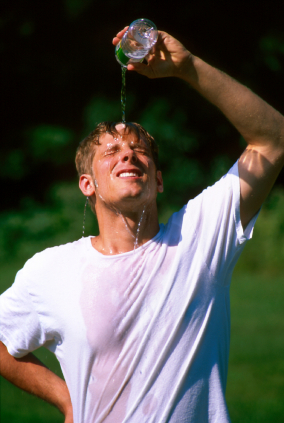Athletes who exercise in hot or humid weather are prone to three, progressively more serious, heat illnesses:
- Heat cramps
- Exertional heat exhaustion
- Exertional heat stroke
Symptoms of impending heat illness
 In addition to educating young
athletes about both the importance of hydration and the dangers of
heat-related illness, ensuring that they drink enough fluids, and taking precautions to reduce the risk of heat injury in children in hot and humid weather,
you need to watch your child for symptoms of impending heat illness:
In addition to educating young
athletes about both the importance of hydration and the dangers of
heat-related illness, ensuring that they drink enough fluids, and taking precautions to reduce the risk of heat injury in children in hot and humid weather,
you need to watch your child for symptoms of impending heat illness:
- Fatigue and tiredness
- Chills
- Nausea
- Headache
- Disorientation
- Muscle cramping
- Lightheadedness
- Dizziness
- Thirst
- Grumpiness and irritability
- Feeling hot
- Trouble concentrating
A child continuing to exercise when experiencing any of these symptoms could suffer a heat illness.
Heat Cramps
Overview
- Painful muscle spasms
- Not a medical emergency
- Can be treated by first aid responders
- Usually occurs during or after exercise
- Usually starts by affecting specific muscles exercised
- Can increase in severity by increasing the number of muscles affected
- In severe cases can involve all skeletal muscles in the body
- Probably results from
- Dehydration (either from fluid losses from sweating or failure to re-hydrate during or after sports)
- Electrolytes lost through sweat (salt, potassium, magnesium etc.)
- Fatigue
- No medical attention required
- Usually occurs during or after exercise
- Usually affects only specific muscles exercised
- Probably results from an imbalance of the body's fluid and electrolyte concentrations caused by a loss of electrolytes in sweat.
Symptoms:
- Muscle pain or feeling of "twinges"
- Spasms
- Visually seeing muscles tighten
- Possible nausea and thirst as result of dehydration occuring at same time
Treatment:
- Remove from practice, game or exercise
- Move child to shade
- Have child sip or drink fluids with electrolytes (sports drinks) continually until symptoms stop
- Child should avoid excessive fluid consumption (feeling "sloshy")
- General rule of thumb: continue sipping or drinking after cramps stop until the child has the urge to urinate
- Gently massage and stretch the affected muscles
- Apply ice bags to affected muscles, if tolerated
- Add salt to foods (not by giving salt tablets)
- If symptoms continue and/or child cannot tolerate fluids by mouth, take child to hospital or doctor (no need to call ambulance)
Exertional Heat Exhaustion
What is heat exhaustion?
- A serious heat illness
- May require medical attention
- Probably results from a reduced blood volume due to excessive sweating, which causes blood to pool in the extremities, causing the child to faint or feel dizzy.
Heat exhaustion symptoms
- Nausea
- Extreme fatigue or "jelly legs"
- Headache
- Shortness of breath
- Weak, rapid pulse
- Thirst or dry mouth
- Rectal temperature less than 104 degrees F.
Heat exhaustion treatment:
- Remove child from practice or game
- Move child out of sun to a shady place
- Have the child sip or drink fluids containing electrolytes
(sports drinks) until the symptoms are gone
- Avoid excessive drinking (child has "sloshy" feeling)
- Good rule of thumb: have child continue sipping after cramps are gone and child has an urge to urinate
- Remove excessive clothing
- Cool (mainly for comfort) the child with fans, cold towels/sheets,
misters, or ice bags on arms or legs

- Hold the child out of playing or exercising in the heat for at least one full day. Hold out longer if they experience any symptoms when they try to return.
- Seek medical attention, if no improvement within 15 to 20 minutes
Exertional Heat Stroke (Exercise-Induced Hyperthermia)
Overview
- Life-threatening medical emergency
- Body's temperature is too high
- Left untreated, exertional heat stroke results in death due to organ damage across all body systems (liver, kidney, brain, etc.)
- Until medical help arrives, the key is to immediately lower elevated body temperature
Symptoms
- Excessively high rectal temperature (over 104 degrees)(oral, axillary, tympanic, and temporal measurements are innacurate and cannot be trusted)
- Erratic pulse (strong and rapid or weak and rapid)
- Lack of coordination
- Collapse
- Low blood pressure
- Vomiting
- Headache
- Loss of consciousness and/or seizure
- Shock
- Irritability, confusion, disorientation
- Sweaty skin that may be red/flushed or pale
Treatment
- Call 911
- Remove all excessive clothes
- Ice-water
or cold-water immersion with water continually circulating in:
- Large stock tank or Rubbermaid container
- Baby pool
- Bath tub
- Pond
- Creek
- When not feasible, immediate and continual dousing with water (either from a hose, multiple water containers or shower) combined with fanning and continually rotating cold, wet towels on head and neck until immersive cooling can occur.









